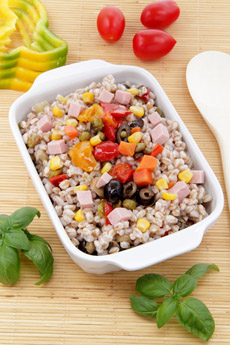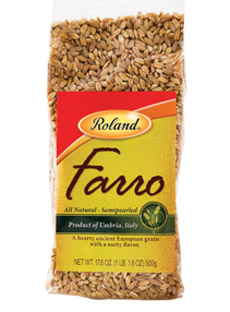TIP OF THE DAY: Try Farro, An Ancient Grain

A “leftovers” salad: farro with cooked |
Farro is the original wheat, one of the first cereals domesticated in the Fertile Crescent. It nurtured the population of the Mediterranean and Middle East for thousands of years. It was cultivated by the ancient Egyptians; it became the staple ration of the Roman Legions; it was ground to create the original polenta.
It has a nutty flavor; a firm, chewy texture; and is lighter in body than traditional grains such as rice and barley. Like arborio rice, farro releases a creamy liquid similar when cooked and can be used to make a [chewier] risotto. Because it was harder to grow and produced lower yields, farro, an unhybridized form of wheat, took a back seat to higher-yielding hybrids. By the beginning of the 20th century, there were a just a few hundred acres under cultivation in Italy and little was grown elsewhere, except in Ethiopia (where emmer constitutes about 7% of the wheat crop). Gourmet restaurants saved the farro crop—or rather, it was saved by the farmers of the French Haute Savoie who brought their product to them. Always seeking something new to please their clientele, chefs embraced farro in soups, stews and sides. Their foodie clients wanted more, and the health-conscious discovered the nutrition of this whole grain. Today, you can find it at the supermarket. |
|
|
FARRO IS NOT SPELT; IT IS EMMER WHEAT Farro looks rather like spelt, another early version of wheat; but they are not the same. Farro is emmer wheat, the original wheat. The botanical name for farro and emmer wheat is Triticum dicoccum; spelt is Triticum spelta; our modern wheat is Triticum aestivum. Whole grain farro is high in fiber plus magnesium and vitamins A, B, C and E. It has less gluten than other varieties of wheat, making it easier to digest. As with other grains, it can be ground into flour to make bread and pasta. |
||
|
Pick up a bag of farro on your next trip to the food store. |

If you can’t find farro in your local market, check at natural foods stores. Photo courtesy Roland. |
|
|
What’s your favorite way to use farro? Let us know!
|
||


